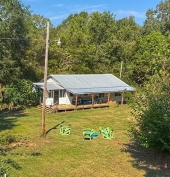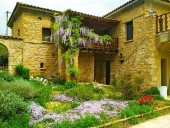posted 14 years ago
Hello all, this is my first post on this forum. I'm from Argentina but I've been living in the USA for a number of years and will continue to live here for at least another 5-10 years (that's how things stand now). I recently purchased 8 hectares (20 acres) of land in Argentina, in the province of Mendoza, near the city of San Rafael. I'd like to give some information about the area in general and the property that I bought, so that people can chime in with comments or suggestions.
The region
The San Rafael area is at 34.6° of latitude South and 68° of longitude West. The altitude is 500 m (1600 ft). There are two rivers that originate in the Andes mountains whose waters are channeled into the farms for irrigation. The soil is sandy. Farms in the area mainly produce grapes, peaches, pears, plums, cherries, and olives. It seems that you can grow pretty much anything that can withstand some freezes. There is also cattle, pig, sheep, and goat ranching. During the summer, the typical daily temperature range is 16 to 32 °C (60 to 89 °F) and in the winter the range is 1 to 16 °C (34 to 61 °F). Average annual rainfall is 40 cm (16 in.) Occasional light snows are not uncommon. Heavy snows are rare. The main natural enemy is hail storms during the summer months. Some farmers install a (quite expensive) net over their fruit trees or grape trellises to protect them from hail. There are two ways to irrigate: dig a well about 70 m (230 ft.), or if the property has water rights, you get surface water distributed through a systems of canals. What farmers typically do is plow the soil and create small trenches in between the rows of trees that get flooded when they open their gate.
A vineyard at the end of winter. As you can see, what they try to do is plant a whole area with the same thing, and kill everything else. They also need to fertilize, as the soil is poor in organic matter to begin with. I don't agree with the "monoculture, fertilize, kill-everything-else" philosophy.
Another vineyard, with anti-hail netting
A fruit tree plantation. The skinny trees in the background are poplars, which are often used as wind break.
Another vineyard (lots of vineyards in this region). You can see a canal that is still wet. In the background, the majestic Andes.
My property
My land is a rectangle of 259 by 316 m (285 by 348 ft). It is leveled and there is nothing planted on it except for a few old olive trees.
A manifold outside the property. There is a main canal, and four gates that distribute water to four farms. The department of irrigation generates a schedule that tells each farmer when they are supposed to open their gate. I get water once a week for three hours. A few farms have a pond that collects the irrigation water.
One of a handful of trees in the property, a mature olive. Otherwise, it's just dirt with grasses growing on it. (This picture was taken in the summer)
A whole bunch a dirt waiting to be used. (This one was taken at the end of winter)
For the foreseeable future I will most likely remain in the USA, so the works I can do on the land will be either whenever I can make a trip there, or through a worker on-site that has offered his services. What I would like to do is to turn the land into a forest and build a small house to vacation or possibly someday retire there and live off the land. I haven't taken pictures of the trees that grow in the region, but there are all kinds of trees, and many of them are huge. Gigantic eucalyptus, oaks, pines, cypresses, deodar cedars (my favorite tree), almond trees, araucaria araucana, firs, poplars, you name it. I would like to have fruit trees of all kinds, and also shade trees for the summer. I would also like to build a pond ecosystem with aquatic plants, fishes, ducks, etc. Obviously some of these things can only be done properly when one is living there, but I'd like to get started with trees, since they take many years to grow.
One thing I learned is that it is cost prohibitive to buy a whole bunch of saplings at a nursery. While the common fruit trees might be inexpensive, a fir or a deodar cedar or any of the other nice conifers could cost north of $100 (US dollars). Not a big deal if you need a handful of them for a backyard, but with several acres, it would take a small fortune. I asked in a nursery about planting seeds, but the guy didn't seem interested at all in explaining how to do that. I guess nurseries are in the business of selling saplings, not seeds.
I would welcome any comments or suggestions about what to do with this land. I am eager to develop it into something beautiful and productive, although I don't have a plan. I am new to permaculture and farming in general. I bought the Mollison and Sepp Holzer books, but a lot of their concepts go over my city-dweller head.Thanks in advance.













































